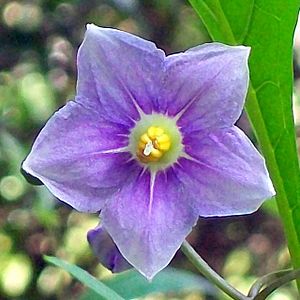Poroporo facts for kids
Quick facts for kids Poroporo |
|
|---|---|
 |
|
| Scientific classification | |
| Genus: |
Solanum
|
| Species: |
aviculare
|
| Synonyms | |
and see text |
|
Solanum aviculare, often called poroporo (in New Zealand), kangaroo apple, or New Zealand nightshade, is a soft-wooded shrub. It grows naturally in New Zealand and along the east coast of Australia.
Contents
About the Kangaroo Apple
Its Discovery and Family
The kangaroo apple, Solanum aviculare, was first described by a German scientist named Georg Forster in 1786. He found it during a trip to New Zealand.
This plant is quite similar to another plant called Solanum laciniatum. People sometimes get them mixed up! But there are ways to tell them apart. S. aviculare usually has smaller, pale blue flowers, sometimes dark purple or white. Its seeds are also smaller, about 2 millimeters long. You can find S. aviculare in places like the Kermadec Islands and the northern parts of New Zealand.
On the other hand, S. laciniatum has bigger, darker purple flowers. Its seeds are larger, about 2 to 3 millimeters long. This plant is more common in the southern parts of New Zealand.
Different Types of Kangaroo Apple
There are also a couple of special types, or varieties, of S. aviculare:
- Solanum aviculare var. albiflorum
- Solanum aviculare var. latifolium
What the Kangaroo Apple Looks Like
The Solanum aviculare is an upright shrub that can grow quite tall, up to 4 meters (about 13 feet). Its leaves are usually 8 to 30 centimeters (about 3 to 12 inches) long. They can be smooth or have different shapes, sometimes with deep cuts or lobes.
The flowers of this plant have both male and female parts. They can be white, light purple, or blue-violet in color and are about 25 to 40 millimeters (1 to 1.5 inches) wide. After the flowers, the plant grows berries. These berries are about 10 to 15 millimeters (0.4 to 0.6 inches) wide. It's important to know that the berries are poisonous when they are green. But once they turn orange, they become safe to eat.
Where the Kangaroo Apple Grows
You can find Solanum aviculare growing in rainforests, wet forests, and along the edges of rainforests. It prefers to grow in clay soils. In Australia, it often grows near other rainforest plants like Golden Sassafras and Lillypilly. It also grows with wet forest trees like Brown Barrel and Turpentine.
How the Kangaroo Apple Grows
Pollination and Reproduction
Bees are thought to play an important role in helping the kangaroo apple reproduce. They visit the flowers and help spread pollen, which allows the plant to create seeds and grow new plants.
Uses of the Kangaroo Apple
The leaves and unripe fruits of the kangaroo apple contain a special natural chemical called solasodine. This chemical is important because it can be used to make certain medicines.
Because of this, S. aviculare is grown in places like Russia and Hungary. The solasodine is taken out of the plant and used as a starting material for making some types of medicine.
This plant is also used in another interesting way: as a base for grafting eggplant. Grafting is when you join parts of two plants together so they grow as one.
Long ago, Aboriginal people in Australia used the fruit of the kangaroo apple. They would make a special paste from it and put it on swollen joints. The plant contains a type of steroid that is important for making a medicine called cortisone.
See also
 In Spanish: Poroporo para niños
In Spanish: Poroporo para niños

